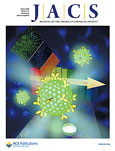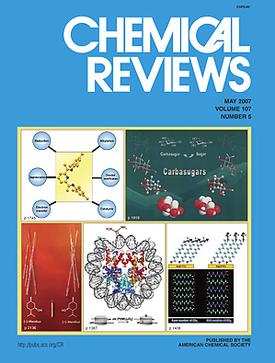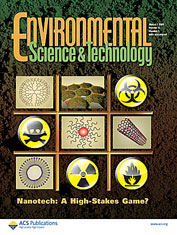Microfluidics refers to a system that manipulates a small amount of fluids ((10-9 to 10-18 liters) using small channels with sizes ten to hundreds micrometres. It is a multidisciplinary field that involves molecular analysis, biodefence, molecular biology, and microelectronics. It has practical applications in the design of systems that process low volumes of fluids to achieve multiplexing, automation, and high-throughput screening. Microfluidics emerged in the beginning of the 1980s and is used in the development of inkjet printheads, DNA chips, lab-on-a-chip technology, micro-propulsion, and micro-thermal technologies.
A lab-on-a-chip (LOC) is a device that integrates one or several laboratory functions on a single integrated circuit of only millimeters to a few square centimeters to achieve automation and high-throughput screening. LOCs can handle extremely small fluid volumes down to less than pico-liters. Lab-on-a-chip devices are a subset of microelectromechanical systems (MEMS) devices and sometimes called "micro total analysis systems" (µTAS). LOCs may use microfluidics, the physics, manipulation and study of minute amounts of fluids. However, strictly regarded "lab-on-a-chip" indicates generally the scaling of single or multiple lab processes down to chip-format, whereas "µTAS" is dedicated to the integration of the total sequence of lab processes to perform chemical analysis. The term "lab-on-a-chip" was introduced when it turned out that µTAS technologies were applicable for more than only analysis purposes.
Electrohydrodynamics (EHD), also known as electro-fluid-dynamics (EFD) or electrokinetics, is the study of the dynamics of electrically charged fluids. It is the study of the motions of ionized particles or molecules and their interactions with electric fields and the surrounding fluid. The term may be considered to be synonymous with the rather elaborate electrostrictive hydrodynamics. ESHD covers the following types of particle and fluid transport mechanisms: electrophoresis, electrokinesis, dielectrophoresis, electro-osmosis, and electrorotation. In general, the phenomena relate to the direct conversion of electrical energy into kinetic energy, and vice versa.

The Journal of the American Chemical Society is a weekly peer-reviewed scientific journal that was established in 1879 by the American Chemical Society. The journal has absorbed two other publications in its history, the Journal of Analytical and Applied Chemistry and the American Chemical Journal. It covers all fields of chemistry. Since 2021, the editor-in-chief is Erick M. Carreira. In 2014, the journal moved to a hybrid open access publishing model.

ChemComm, formerly known as Journal of the Chemical Society D: Chemical Communications (1969–1971), Journal of the Chemical Society, Chemical Communications (1972–1995), is a peer-reviewed scientific journal published by the Royal Society of Chemistry. It covers all aspects of chemistry. In January 2012, the journal moved to publishing 100 issues per year. The current chair of the Editorial Board is Douglas Stephan, while the executive editor is Richard Kelly.

Chemical Reviews is peer-reviewed scientific journal published twice per month by the American Chemical Society. It publishes review articles on all aspects of chemistry. It was established in 1924 by William Albert Noyes. As of 1 January 2015 the editor-in-chief is Sharon Hammes-Schiffer.

Accounts of Chemical Research is a semi-monthly peer-reviewed scientific journal published by the American Chemical Society containing overviews of basic research and applications in chemistry and biochemistry. It was established in 1968 and the editor-in-chief is Cynthia J. Burrows.

Inorganic Chemistry is a biweekly peer-reviewed scientific journal published by the American Chemical Society since 1962. It covers research in all areas of inorganic chemistry.
Photochemical & Photobiological Sciences is a monthly peer-reviewed scientific journal covering all areas of photochemistry and photobiology. It was established in 2002 and is published by Springer Science+Business Media on behalf of the European Photochemistry Association and the European Society for Photobiology. The editors-in-chief are Dario Bassani and Rex Tyrrell.

Nanofluidics is the study of the behavior, manipulation, and control of fluids that are confined to structures of nanometer characteristic dimensions. Fluids confined in these structures exhibit physical behaviors not observed in larger structures, such as those of micrometer dimensions and above, because the characteristic physical scaling lengths of the fluid, very closely coincide with the dimensions of the nanostructure itself.

Environmental Science & Technology is a biweekly peer-reviewed scientific journal published since 1967 by the American Chemical Society. It covers research in environmental science and environmental technology, including environmental policy. Environmental Science & Technology has a sister journal, Environmental Science & Technology Letters, which publishes short communications.
Optoelectrofluidics, also known as optically induced electrohydrodynamics, refers to the study of the motions of particles or molecules and their interactions with optically-induced electric field and the surrounding fluid.
Nanofluidic circuitry is a nanotechnology aiming for control of fluids in nanometer scale. Due to the effect of an electrical double layer within the fluid channel, the behavior of nanofluid is observed to be significantly different compared with its microfluidic counterparts. Its typical characteristic dimensions fall within the range of 1–100 nm. At least one dimension of the structure is in nanoscopic scale. Phenomena of fluids in nano-scale structure are discovered to be of different properties in electrochemistry and fluid dynamics.

Chemical Science is a weekly peer-reviewed scientific journal covering all aspects of chemistry. It is the flagship journal of the Royal Society of Chemistry. It was established in July 2010 and is published by the Royal Society of Chemistry; before 2018, it was published monthly. It won the Best New Journal 2011 award from the Association of Learned and Professional Society Publishers. The editor-in-chief is Andrew Ian Cooper.

Nam-Trung Nguyen is a Vietnamese-Australian researcher in the fields of Microfluidics and Nanofluidics. He is notable for his work on nerve agent detector, PCR, Micromixer, Droplet-based Microfluidics, Micro Magnetofluidics, Liquid Marbles and Micro Elastofluidics. He is currently a Professor and Director of Queensland Micro and Nanotechnology Centre at Griffith University. He was a former Associate Professor at Nanyang Technological University, Singapore. Nguyen is a Fellow of ASME and a Senior Member of IEEE.
Suman Chakraborty is Professor at the Indian Institute of Technology Kharagpur and Sir J. C. Bose National Fellow ,. He has served as the Dean, Research and Development, Associate Dean and the Head of the School of Medical Science and Technology of the Institute. He has also been Institute/ National Academy of Engineering Chair Professor. He joined the Institute in 2002 as Assistant Professor and has been a Full Professor since 2008.

Eugenia Kumacheva is a University Professor and Distinguished Professor of Chemistry at the University of Toronto. Her research interests span across the fields of fundamental and applied polymers science, nanotechnology, microfluidics, and interface chemistry. She was awarded the L'Oréal-UNESCO Awards for Women in Science in 2008 "for the design and development of new materials with many applications including targeted drug delivery for cancer treatments and materials for high density optical data storage". In 2011, she published a book on the Microfluidic Reactors for Polymer Particles co-authored with Piotr Garstecki. She is Canadian Research Chair in Advanced Polymer Materials. She is Fellow of the Royal Society (FRS) and a Fellow of the Royal Society of Canada (FRSC).
Physical Review Fluids is a peer-reviewed scientific journal, published monthly by the American Physical Society. The journal focuses on fluid dynamics and also covers geophysical fluid dynamics, biofluid dynamics, nanofluidics and magnetohydrodynamics. Its lead editors are Eric Lauga and Beverley McKeon.

Andrew James deMello is a British chemist and Professor of Biochemical Engineering at ETH Zürich.
Microfluidics refers to the flow of fluid in channels or networks with at least one dimension on the micron scale. In open microfluidics, also referred to as open surface microfluidics or open-space microfluidics, at least one boundary confining the fluid flow of a system is removed, exposing the fluid to air or another interface such as a second fluid.










